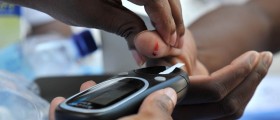Tingling sensation can be described as if the skin is being pinched or poked with pins and needles. Numbness, on the other hand, is a disturbance in which the skin simply cannot recognize certain sensations such as pain, heat, etc. These two symptoms may affect every portion of the skin; hence may affect every part of the body.
These sensations always occur if there is compression, irritation, or damage to the nerves that innervate the specific area of the skin. So, in the case of tingling and numbness in fingers, the problem is associated with nerves in charge of the skin of this particular area.
Causes of Tingling and Numbness in Fingers
As it has already been mentioned, any kind of injury or illness which may cause compression, irritation, or damage to certain nerves leads to the occurrence of tingling and numbness in fingers.

Nerve injury may be caused by inflammation, lack of blood supply, or direct compression and infiltration of the nerve. Initially, tingling and numbness may be transitory, and only if the nerve or certain parts of the nerve are completely destroyed the person will have to deal with lifetime tingling and numbness. Nerve damage and subsequent tingling and numbness of fingers are common for people suffering from peripheral neuropathy, diabetes, multiple sclerosis, carpal tunnel syndrome, and ganglion cysts in the wrist or hands.
- Within the Danish NUDATA study, vibratory sensory testing with monitoring of the digital vibration threshold at seven frequencies on the second and fifth fingers of both hands was performed on 20 cases with unilateral tingling/numbness in the hands and fingers, and 20 gender- and age-matched controls.
- Both cases and controls were identified from questionnaire information about tingling/numbness at least once a week or daily within the last 3 months. Participants with more than slight muscular pain or disorders of the neck and upper extremities, excessive alcohol consumption, previous injuries of the upper extremities, or concurrent medical diseases were excluded. The two groups had a similar amount of work with mouse, keyboard, and computer.
- Seven of the 20 cases (35%) had elevated vibration thresholds, compared with 3 of the 20 controls (15%); this difference was not statistically significant (chi2=2.13, P=0.14). Compared with controls, cases had increased perception threshold for all frequencies, but the difference was statistically significant for only 2 out of 14 measurements.
- Comparison between left and right hand threshold values within the case group did not show any significant difference at any frequency.
Some transitory conditions such as electrolyte imbalance, changes in blood sugar levels, migraines, or anxiety may be responsible for irreversible tingling and numbness in fingers.
Furthermore, tingling and numbness in fingers may be associated with several more medical conditions such as hypothyroidism, lack of certain vitamins, stroke, and intake of certain medications. And finally, this is a common side effect of chemotherapy and radiation therapy of specific body parts.
Treatment for Tingling and Numbness in Fingers
If these symptoms become more frequent or tend to linger, one is supposed to consult his/her health care provider. It is essential to identify and treat the underlying cause of tingling and numbness in fingers and treat the condition. This way, permanent damage to the affected nerve can be prevented.
People whose nerves have been seriously damaged have to face persistent symptoms, and they are at higher risk of certain complications such as burns or frostbites. Namely, reduced or complete loss of sensation in fingers makes one unable to recognize hot or cold temperatures, and this may cause accidental injuries.
People who are suffering from permanent numbness of fingers are supposed to take protective measures every time they are manipulating either too hot or too cold objects.




-in-Multiple-Sclerosis_f_280x120.jpg)











-Causes,-Symptoms,-Diagnosis,-Treatment_f_280x120.jpg)
Your thoughts on this
Loading...